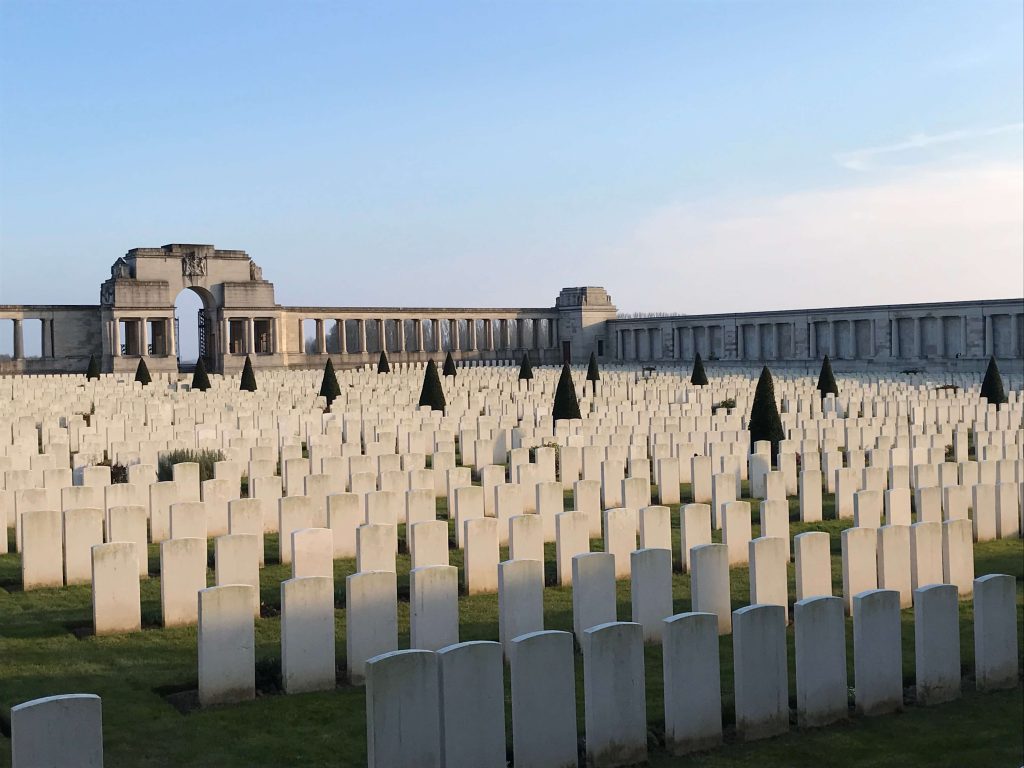
Loire ~ Chartres ~ Paris ~ Somme ~ Pozières
Chateau d’Amboise
Sunday another clear day but more than a little crisp! We fired out into the town to visit the Château d’Amboise, which dominates the town with its high fortified walls.
Continuing a theme, it was confiscated by the monarchy in the 15th century (as Mel Brooks said, it’s good to be the king!). But even if you’re king you still need to watch your head. King Charles VIII died at the château in 1498 after hitting his head on a door lintel – Simon could relate, but mercifully emerged intact.
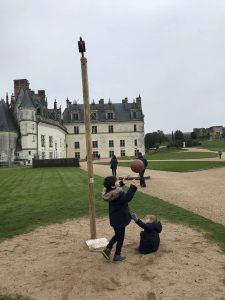
 Niamh was feeling the morning chill fairly acutely (it was about 3 degrees and minus 2 with wind chill) so retired to the safety of the gift shop after a quick tour of the château while Simon and the kids explored the gardens.
Niamh was feeling the morning chill fairly acutely (it was about 3 degrees and minus 2 with wind chill) so retired to the safety of the gift shop after a quick tour of the château while Simon and the kids explored the gardens.
A beautiful setting up above the town, complete with a medieval game of tetherball!
The chapel was a highlight, with the tomb of Leondardo to remind us of the previous day and beautiful stone carvings that like so many in France had miraculously survived the centuries.
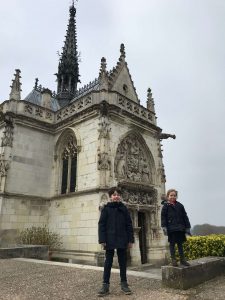
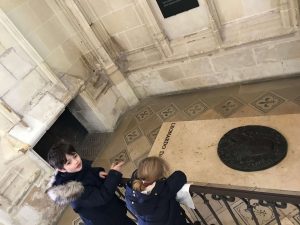
Château de Chambord
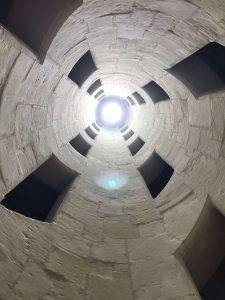
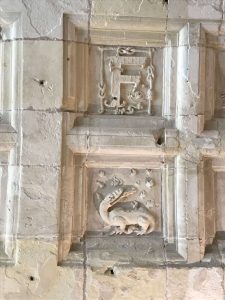 No visit to the Loire complete without a visit to the fantastical renaissance château de Chambord.
No visit to the Loire complete without a visit to the fantastical renaissance château de Chambord.
No need to confiscate this one, built for Louis I directly!
A triumph of form over practicality, it was freezing and unheatable in winter (we could attest to that!) and mosquito infested in the summers. For a couple of weeks in between it was lovely.
Nevertheless an extraordinary structure that was and remains an object of fascination, in particular the double helix stone staircase that sits at the centre of it.
By now the creeping cold had gotten to Aisling too, so after a quick whip around the girls both retired to the copious gift shop leaving the boys to continue exploring.
Charles found a display of all the keys to the chateau and imagined exploring secret passages. We admired the staircase and made our way up separate spirals, spotting each other through the cross–cutting windows.
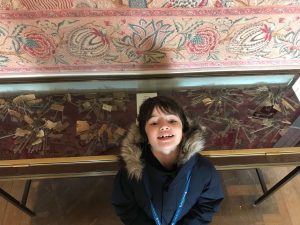
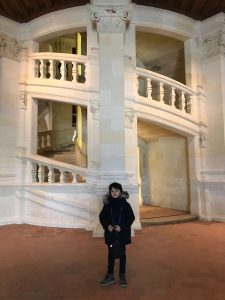
We made our way up to the roof with its explosion of variegated towers and listened through the audio guides to stories from down the ages of theatres built for mistresses and grand receptions!
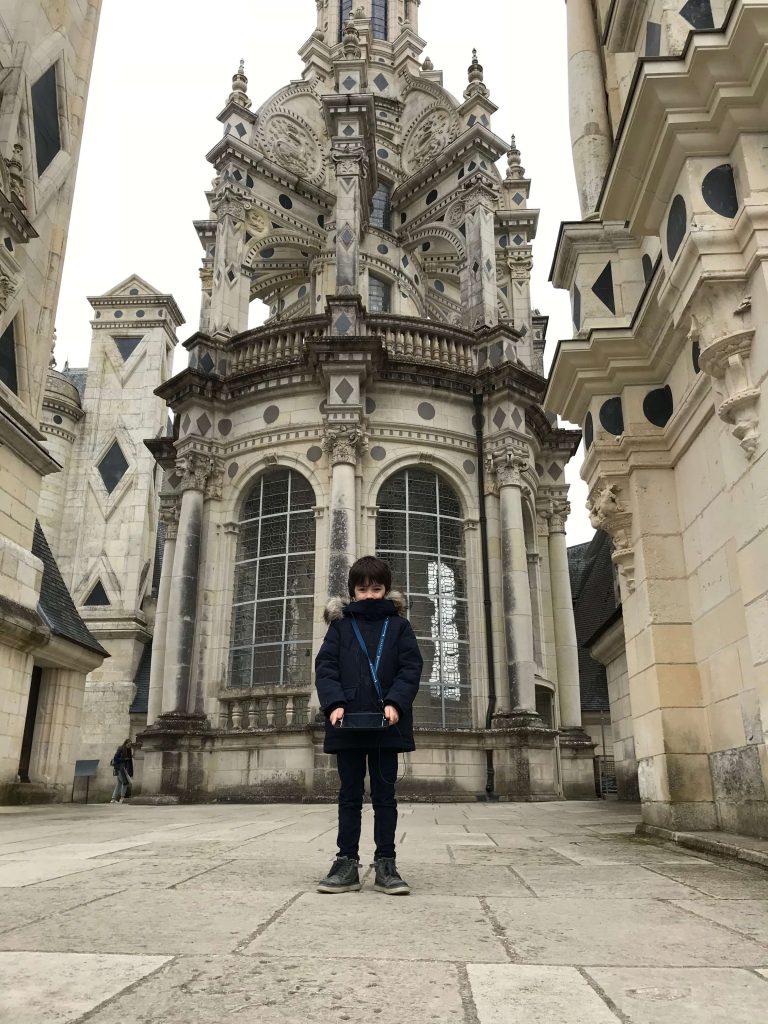
Chartres cathedral
Chartres is a short detour on the way back to Paris.
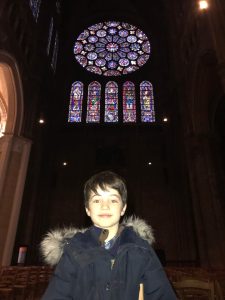
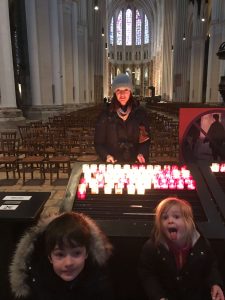 Sitting high on the hill overlooking the city is its magnificent cathedral which is a masterpiece of gothic architecture, with most of the original stained glass intact.
Sitting high on the hill overlooking the city is its magnificent cathedral which is a masterpiece of gothic architecture, with most of the original stained glass intact.
Extraordinary blue hazy light from the stained glass
Amazing stone carving all around the choir that has survived down the centuries…
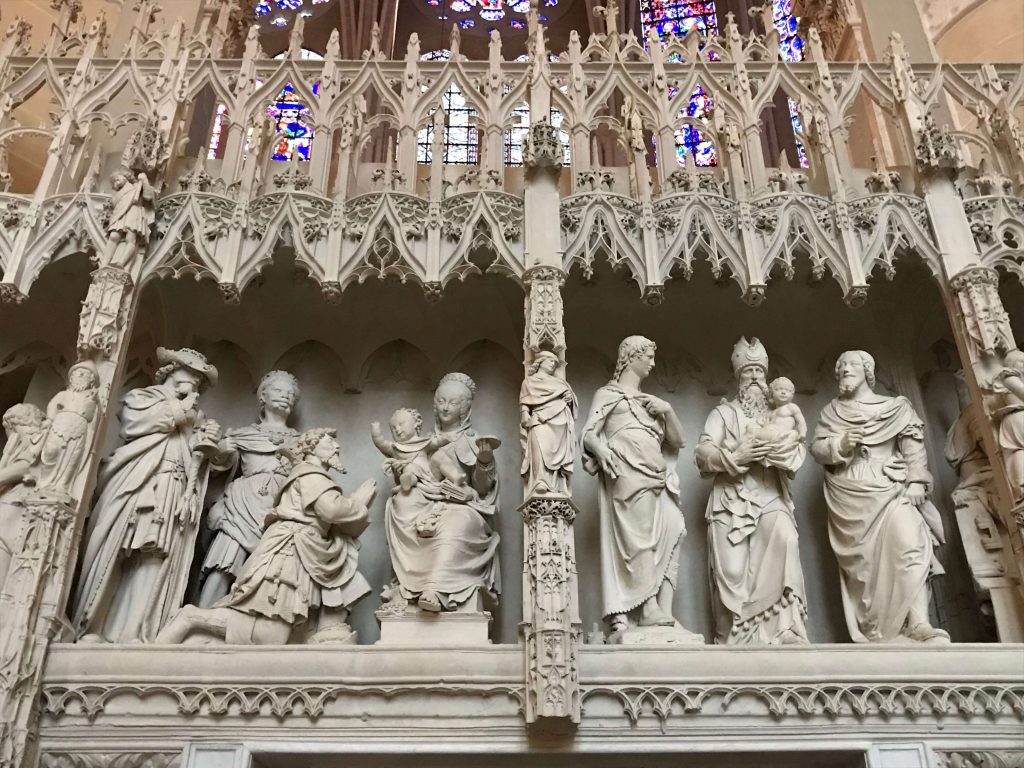
Aisling and Charles took some time to light candles to their grandparents…
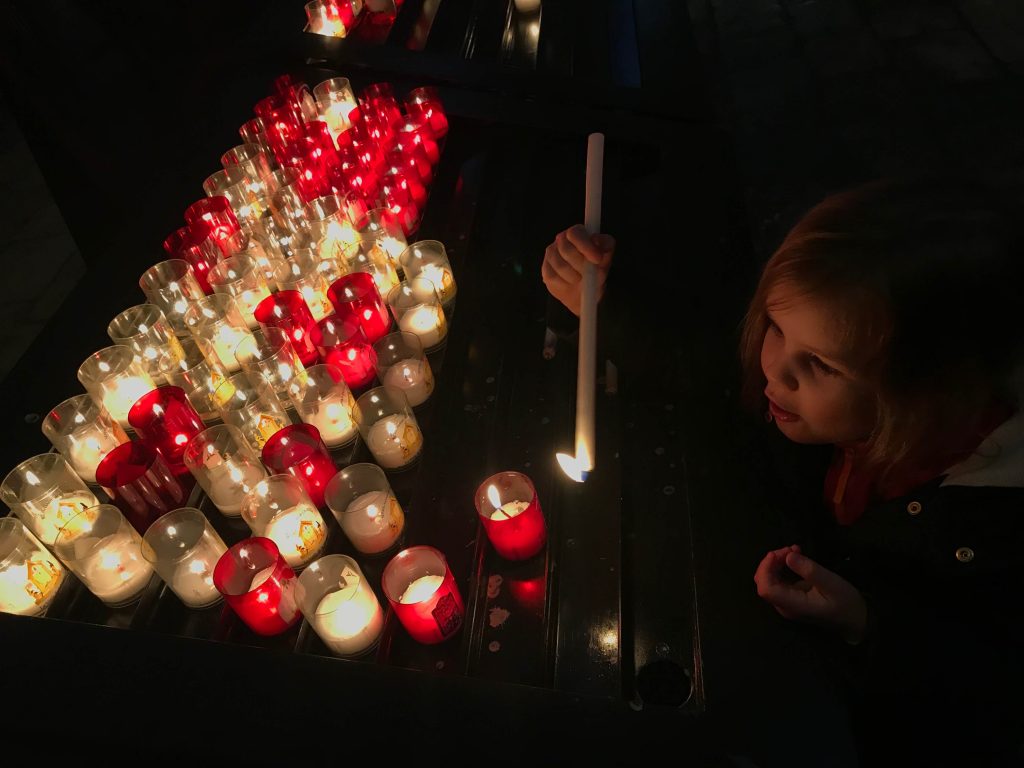

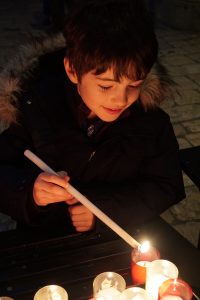 On the way out we admired the Chartres street art before heading back to Paris after a busy weekend.
On the way out we admired the Chartres street art before heading back to Paris after a busy weekend.
Everyone slept well that night!
Snow, Class Photo, Playdate
On the way back to Paris the cold snap turned to snow falling again. Kids delighted, even though this was more a dusting than a thick blanket.
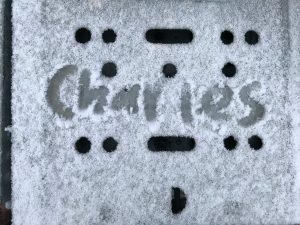

 Aisling proud as punch for her school class photo this week, and looking very much the grown up girl to the chagrin of her parents.
Aisling proud as punch for her school class photo this week, and looking very much the grown up girl to the chagrin of her parents.
Charles meanwhile had a playdate with his schoolfriend Angus. Hamburgers, play at both kids’ houses with some soccer in the park in between makes for a brilliant afternoon under theatrical skies:
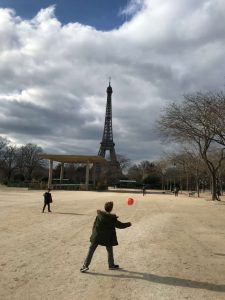
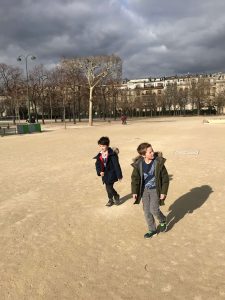
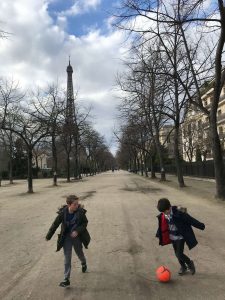
Simon and Niamh out and about in Paris as always – the Seine finally returning to normal levels. The bateaux mouches will soon be running again.
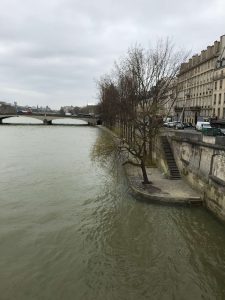
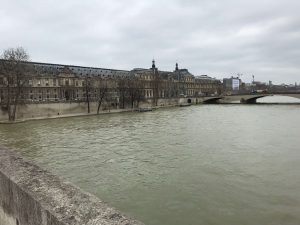
Plaster and bands
Meanwhile, Simon continuing to plug away at the sculpture, plaster bands in place on the cliffs, ready for some plaster shaping…
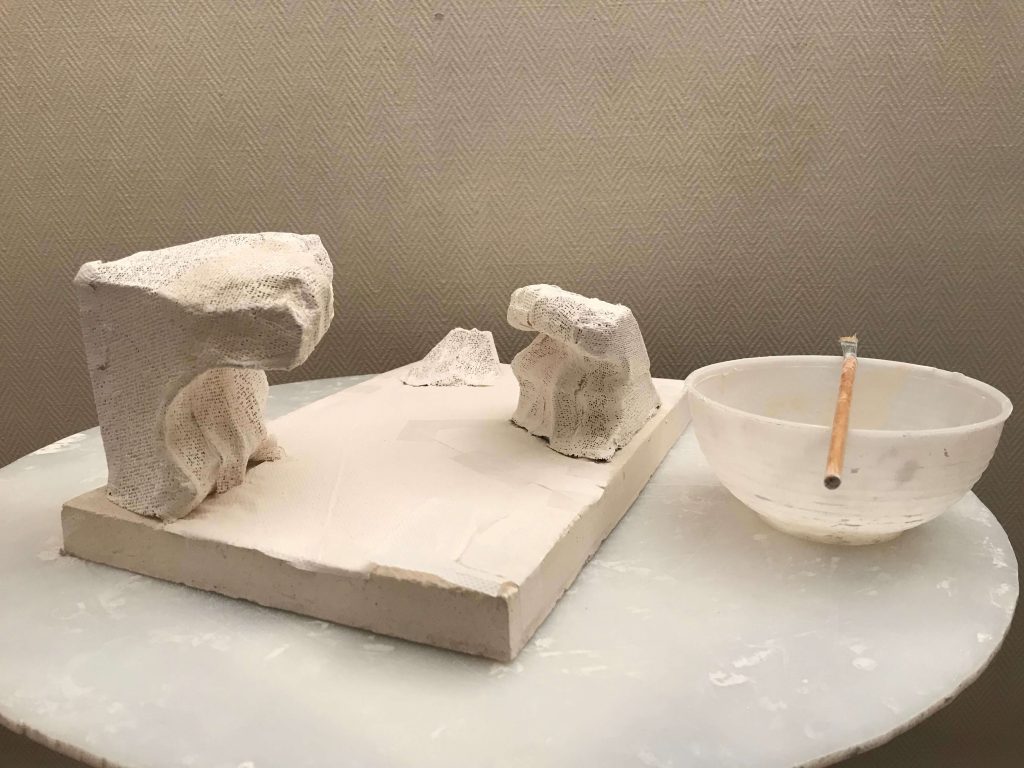
Somme – Omiécourt
The next weekend’s outing had a more sombre theme. Instead of south-west of Paris we were headed north-east, up to the Somme valley, scene of some of the most tragic fighting of WW1 and indeed of human history.
Here between July and November of 1916, more than three million men fought and one million of them were wounded or killed.
This year marks 100 years since the end of the war, and the year in which Australia is unveiling a new memorial at Villiers-Bretonneux. The site has particular relevance to our family since Simon’s grand-uncle Arthur fought there, and was awarded the Victoria Cross for his actions.
 We headed up after school on Friday afternoon, staying in the tiny town of Omiécourt a little south of the Somme.
We headed up after school on Friday afternoon, staying in the tiny town of Omiécourt a little south of the Somme.
We were in a converted manor house that has been in the owners’ family for more than 300 years.
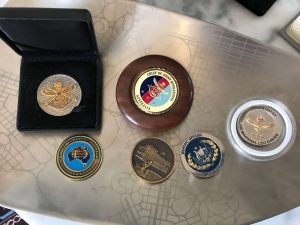 We weren’t the first Australians visiting the Somme to stay there…
We weren’t the first Australians visiting the Somme to stay there…
Charles and Aisling practicing their best breakfast table manners and enjoying the change of scenery…
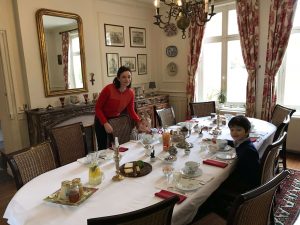

 One of the advantages of the hotel was that it came with an indoor heated pool (and an outdoor hot-tub of you were game for the dash across the lawn).
One of the advantages of the hotel was that it came with an indoor heated pool (and an outdoor hot-tub of you were game for the dash across the lawn).
A welcome change from the frigid Parisian weather of late.
Somme – Albert and Lochnagar
For Saturday we had organised an all-day tour with Jackie Bedford from “the battlefields experience”. Jackie is former British police and army, and she and her husband have been running guided battlefield tours for longer than they would probably care to admit.
Armed with stout gumboots, an encyclopaedic knowledge and a no small amount of British pluck and resolve, she was the perfect guide for the day, and more than delighted to show Arthur’s family around.
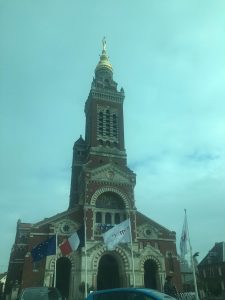
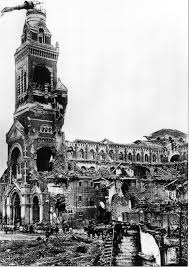 We started in Albert, the main town behind the front lines where the troops would arrive and muster before heading to battle, and where the grim trails of soldiers heading back from the front would lead to.
We started in Albert, the main town behind the front lines where the troops would arrive and muster before heading to battle, and where the grim trails of soldiers heading back from the front would lead to.
In the centre of town stands a basilica with a golden statue of the virgin Mary. German bombing during WWI had caused her to topple forward without falling to the ground.
When the Aussies arrived in 1916 they re-christened her “Fanny” after Fanny Durack, an Australian olympic swimmer who had won a gold medal in the 1912 Olympics.
 Jackie soon met us in her trusty van, and we were off to explore the area.
Jackie soon met us in her trusty van, and we were off to explore the area.
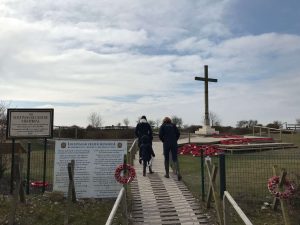 First stop was Lochnagar crater.
First stop was Lochnagar crater.
A feature of the geology of the Somme is that there is a thick chalk layer under the topsoil, which is very easy to tunnel into.
As a result, both sides in the conflict engaged in extensive tunnelling, in efforts to “mine” under the other side’s stronghold positions and set off large stashes of explosives.
Lochnagar crater is just such a site, where the British (specifically Welsh coal miners) had tunnelled under German positions and set off such a massive explosion that the reconnaissance aircraft above saw lumps of soil flying up past the level of the planes:
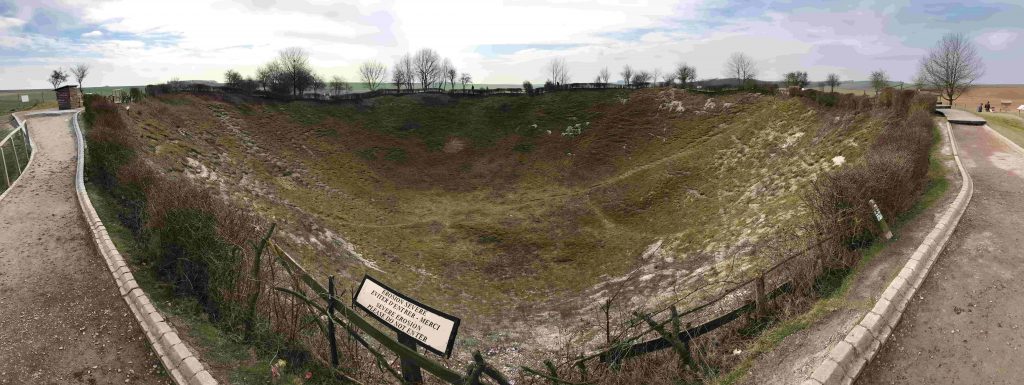
Today the site is a memorial to those who fought and died in the area, as well as to the miners who risked and often lost their lives in the endeavour.
Both sides would be tunnel toward the other, listening for any sound through the chalk. We heard extraordinary stories of digging silently with bayonets at the rate of only a couple of feet per day.
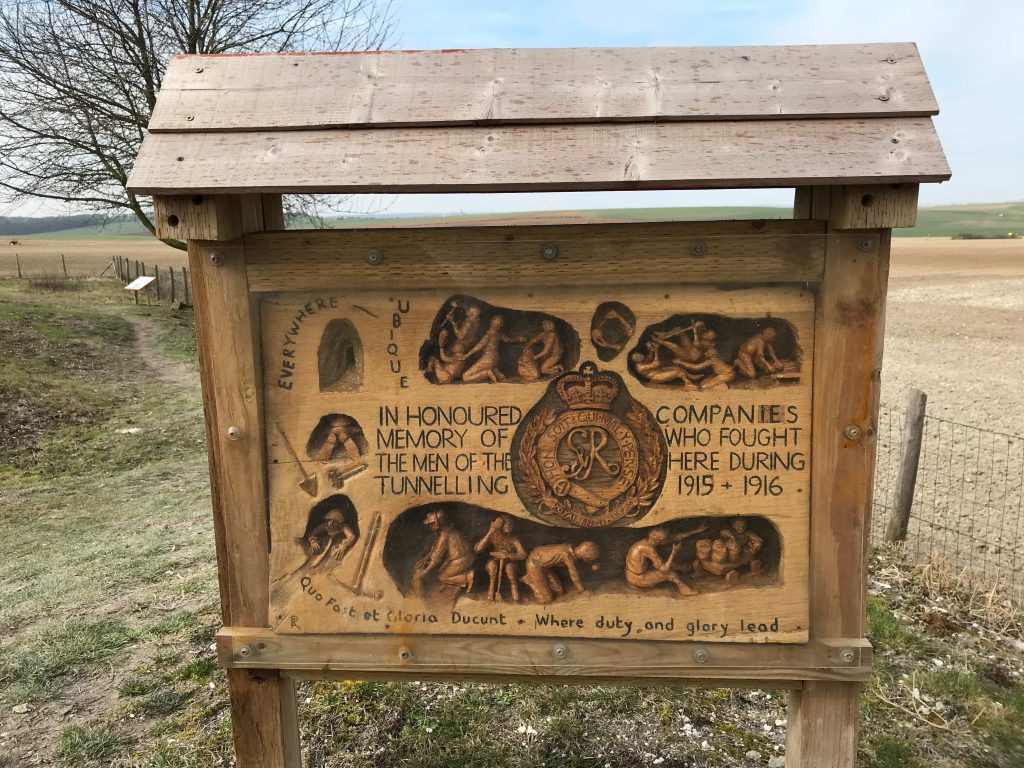
Pozières
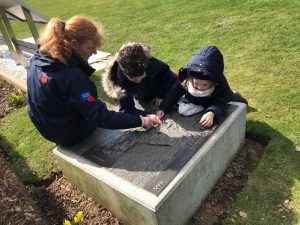 Then it was on to the little town of Pozières, where some of the worst of the fighting took place.
Then it was on to the little town of Pozières, where some of the worst of the fighting took place.
The countryside around Pozières is gently undulating fields with crops growing under bright sun, and the occasional small town dotting the horizon.
Hard to imagine the horrors of this place a little more than 100 years ago – Jackie helped orient us with the help of a sculpted map of the area.
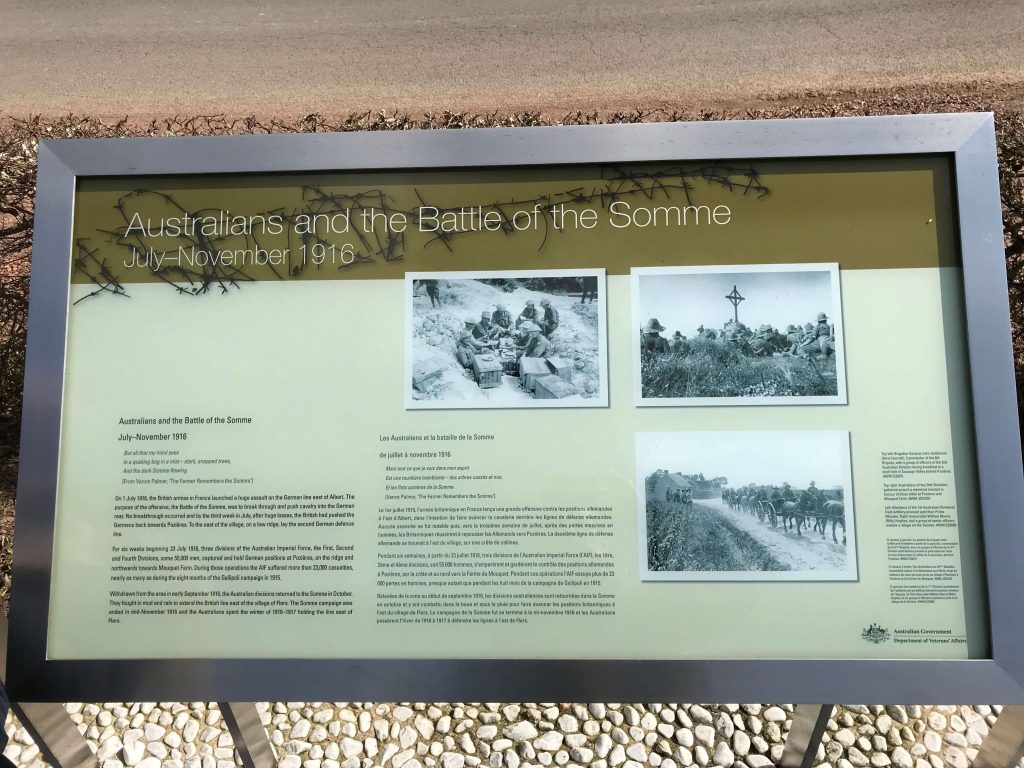
To bring the tour to life, Jackie had an amazingly useful tool with her: an iPad application that was able to overlay the military maps of the day onto your current location. So armed with the iPad you could call up any specific day in the conflict, see exactly where the lines of the trenches were drawn, and walk through the fields to the precise spot where a particular conflict was taking place:
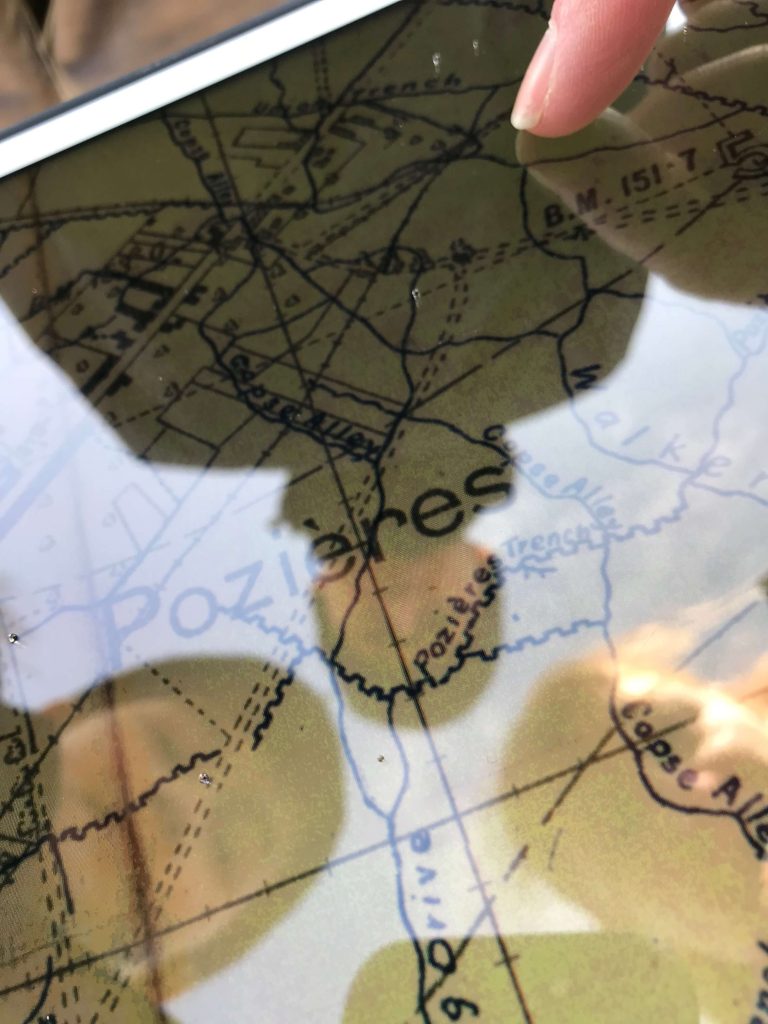
Credit for the above photo to Aisling by the way 🙂
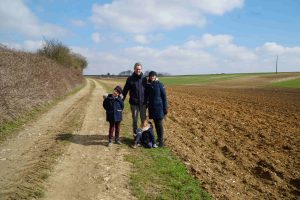 So armed with this tool and Jackie’s seemingly bottomless knowledge of the conflict, we headed out into sun-drenched farmers’ fields to literally walk through history and try to imagine what it would have been like.
So armed with this tool and Jackie’s seemingly bottomless knowledge of the conflict, we headed out into sun-drenched farmers’ fields to literally walk through history and try to imagine what it would have been like.
A visceral reminder along the way was that as you walked along beside the ploughed fields, even 100 years on it’s not too hard to pick up pieces of shrapnel, barbed wire, and even WWI bullets last touched by a soldier’s hand in 1916.
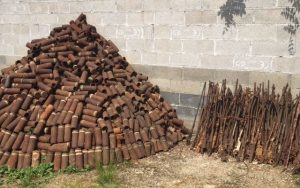 In the early years after the war, dispel teams were removing 400-500 tonnes of ordnance per year. Even in 2016, one hundred years of clean-up later, the total was 25 tonnes and disposal experts predict there will be finds for hundreds of years to come.
In the early years after the war, dispel teams were removing 400-500 tonnes of ordnance per year. Even in 2016, one hundred years of clean-up later, the total was 25 tonnes and disposal experts predict there will be finds for hundreds of years to come.
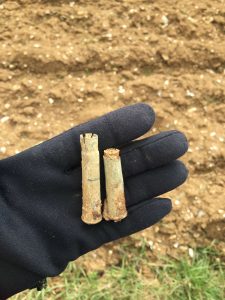 Our team’s keen eyes soon confirmed this by turning up quite a few souvenirs during even a short walk, including bullets with unfired cordite that Jackie proceeded to light to the amusement and fright of us all later on that afternoon out the back of “Le Tommy” cafe.
Our team’s keen eyes soon confirmed this by turning up quite a few souvenirs during even a short walk, including bullets with unfired cordite that Jackie proceeded to light to the amusement and fright of us all later on that afternoon out the back of “Le Tommy” cafe.
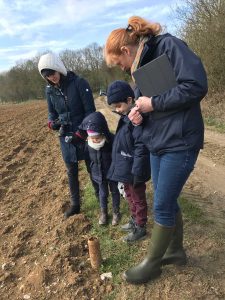
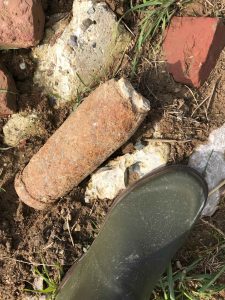 Beyond the small fragments and bullets, there are also shell casings and unexploded shells aplenty.
Beyond the small fragments and bullets, there are also shell casings and unexploded shells aplenty.
In this picture Jackie is showing us a typical example that the farmer has left beside the trail after unearthing it in the field.
Digging too deeply is not recommended. When the front line passed over exactly this same area during WWII, the soldiers on both sides found they were unable to dig trenches due to the number of bodies they encountered. A sobering fact to reflect on.
Another reminder of course are the small cemeteries dotted here and there. Very few obtained a proper burial, nevertheless the cemeteries that jump out from the fields with their white stones serve as very visual reminders.
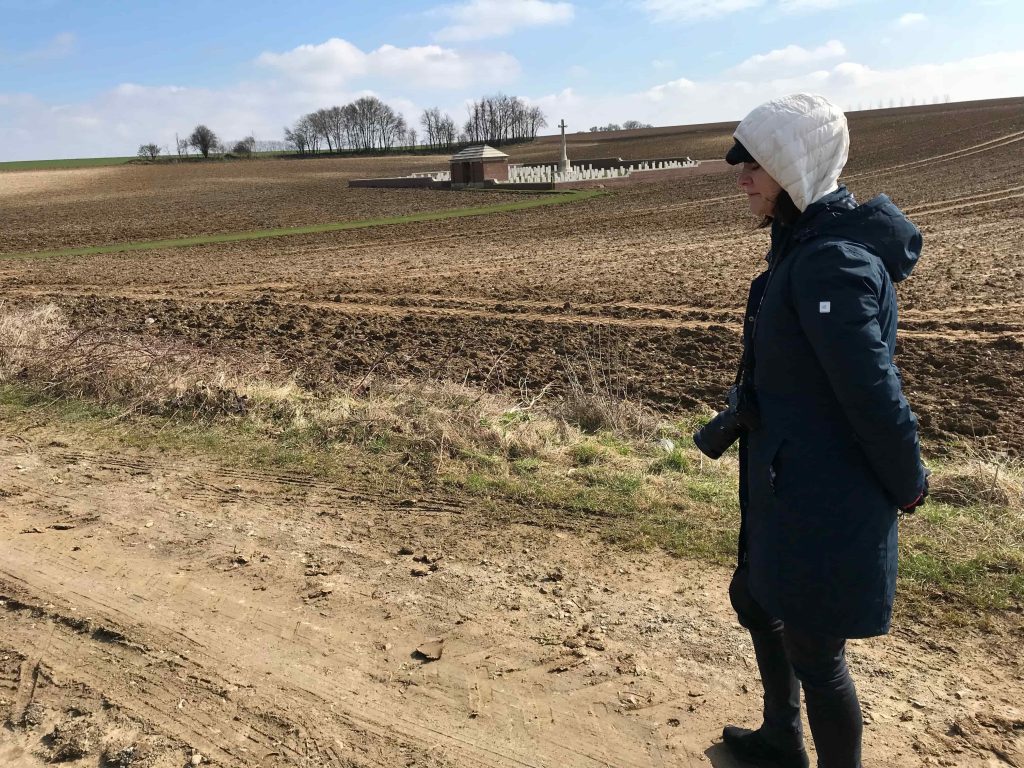
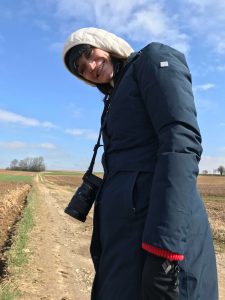
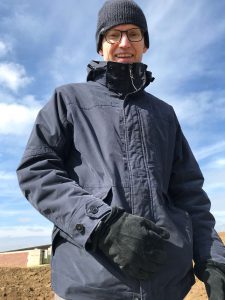 On a somewhat lighter note, Aisling was keen to get in on all the photo taking that was going on, and produced these two portraits of her parents.
On a somewhat lighter note, Aisling was keen to get in on all the photo taking that was going on, and produced these two portraits of her parents.
We think her theme is going to be “looking up at the world” – a great choice when you’re 4.
Clearly a glittering career awaits!
Somme memorials
After the initial walk around the fields of Pozières retracing Arthur’s steps (more on that later), we visited a variety of the impressive memorial sites in the region.
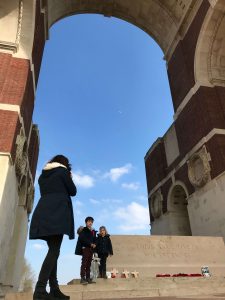
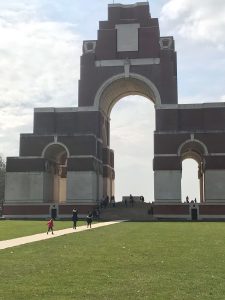 The Thiepval Memorial to the Missing of the Somme is a British memorial to 72,246 missing British and South African servicemen.
The Thiepval Memorial to the Missing of the Somme is a British memorial to 72,246 missing British and South African servicemen.
An enormous edifice with a commanding view, it can be seen for miles in each direction
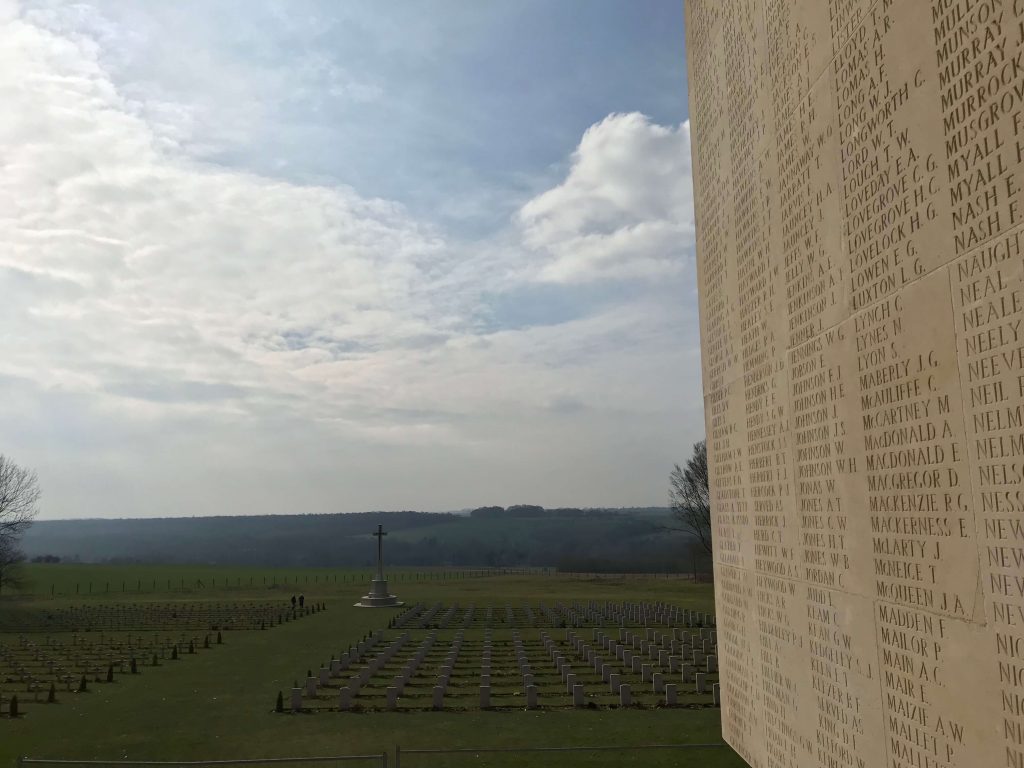
The nearby visitors centre is full of information about the war and the Battle of the Somme, with a 360-degree mural encircling a glass floor full of artefacts from the battle
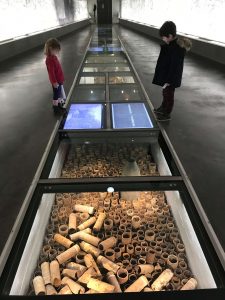
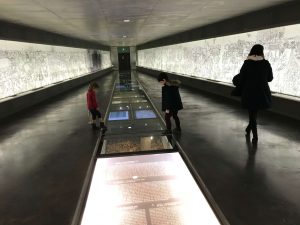
For us however, the most impressive memorials were by the Canadians. Shortly after the end of the war, the Canadian government purchased land at several battlefield sites where their troops had fought in significant battles, and turned them into memorials.
As a result, the Canadian memorials are the ones that have best preserved the sites as they were 100 years ago, and are well worth visiting of you are in the area.
 First we went to the Beaumont-Hamel Newfoundland Memorial, which is the largest battalion memorial on the Western Front, and the largest area of the Somme battlefield that has been preserved.
First we went to the Beaumont-Hamel Newfoundland Memorial, which is the largest battalion memorial on the Western Front, and the largest area of the Somme battlefield that has been preserved.
You can walk in the remnants of trenches, and stand in no mans land and imagine the impossibility of the fighting at close quarters given the close proximity of the deep trench lines and dug-in positions.
.
The symbol of the memorial is the Caribou, just visible in the picture below, set amongst original trenches. As told to us, it was chosen for being an animal that will not leave one if its wounded behind, but will stand by to protect it, even at its own peril…
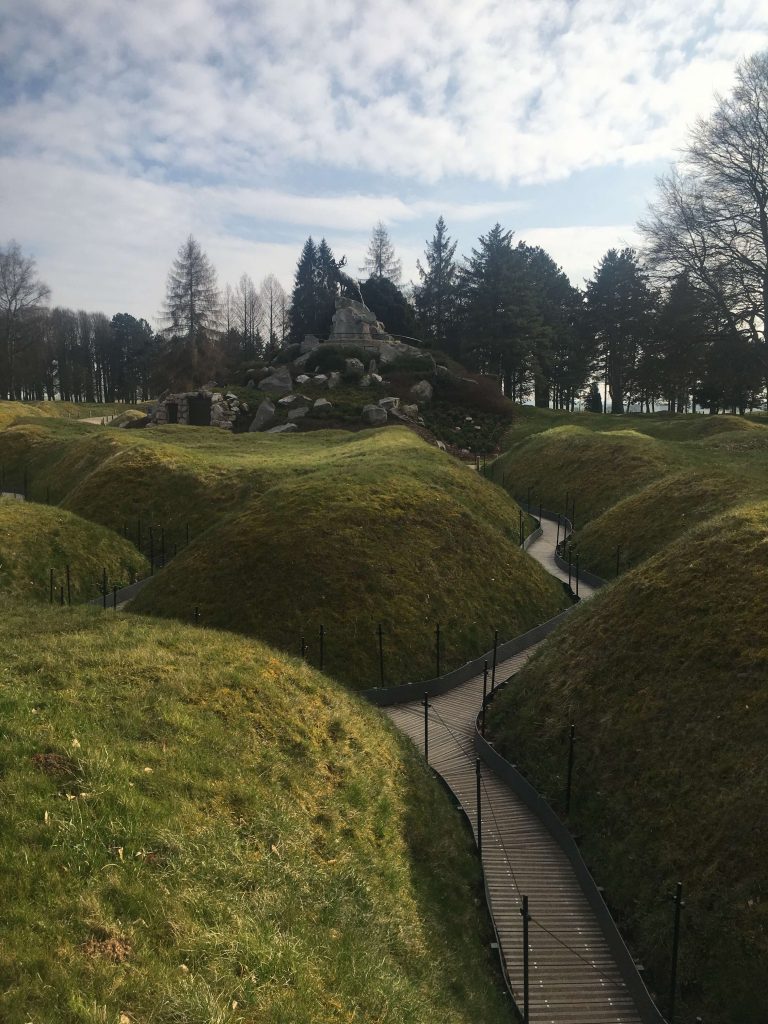
The Canadian memorial at Vimy is even more impressive, but that needed to wait until Sunday – only so many memorials that can be packed into a day!
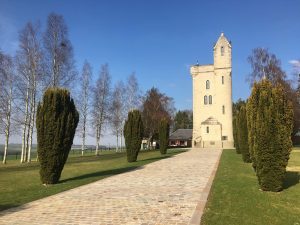 We did however make a fleeting stop at the Ulster monument to the Irish forces who had fought with the allies, and Niamh went out for a short explore.
We did however make a fleeting stop at the Ulster monument to the Irish forces who had fought with the allies, and Niamh went out for a short explore.
Dominique & Le Tommy
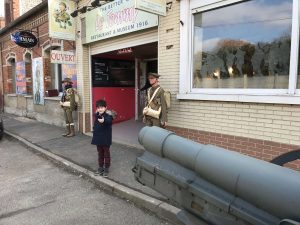 The only place for lunch during a Somme battlefields tour is “Le Tommy” in Pozières.
The only place for lunch during a Somme battlefields tour is “Le Tommy” in Pozières.
Run by Dominique Zanardi it is part museum, part cafe, part live history tour.
Dominique is highly passionate about the WW1 history of the town and region, and an inveterate collector. Also possibly the only person with more knowledge of the area than Jackie herself…
As a result the cafe is stuffed full of artefacts (including an increasing number of tank parts these days), and out the back are rusted rifles, helmets and endless coils of WW1 barbed wire.
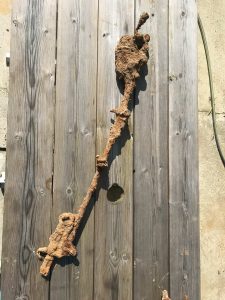
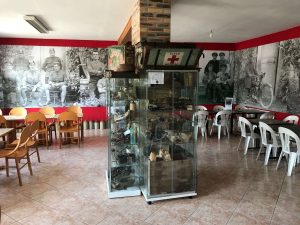
It was out the back of Le Tommy where Jackie fired off the cordite in the WW1 bullet Charles had found, making it safe to travel with. It seemed an appropriate place to be letting off WW1 ordnance! Both kids delighted of course.
Perhaps the most telling image at Le Tommy however was the photo of Pozières taken a short time after the battle, and shown below. This image tells you about all you need to know.
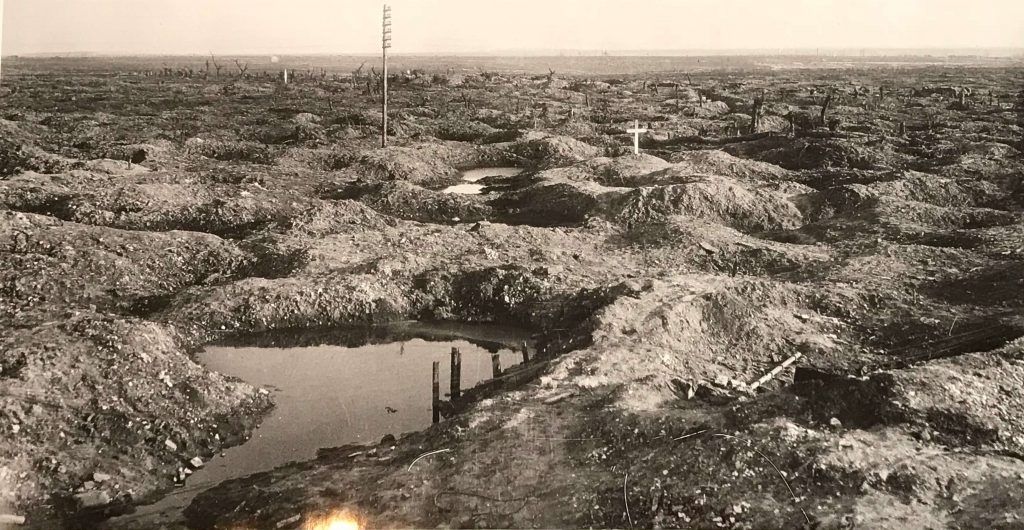
Arthur Seaforth Blackburn
Later in the afternoon it was back to the town of Pozières.
Right at the northern entrance to the town is a water tower that bears the name of the soldiers awarded the Victoria Cross for their bravery during the action, including Arthur Seaforth Blackburn, the younger brother of Simon’s grandfather.

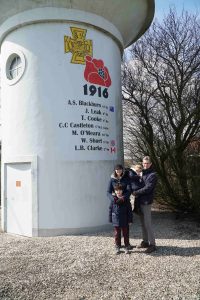
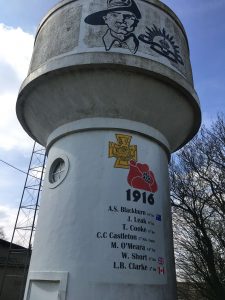
Arthur gained renown for his service in the Australian army in both world wars. In WW1 he was part of the initial landing force at Gallipoli, and along with Philip Robin (a fellow South Australian and college mate) made the furthest inclusion of any allied soldiers into Turkish territory.
By the time he was stationed at Pozières it was late July 2016, and he was a 23 year old second lieutenant.
The worst fighting of the war and what was to become one of the most notorious battles in history had just commenced. Over a 45 day period the allies launched 19 separate offensives (a rate not exceeded during the war), firing 12,000 shells per day. The allies and Germans each lost in the order of half a million men over 4 months.
One cause of the very high casualty rate was the nature of the trench warfare: both sides had very deeply dug and extensive trenches, so that in any attack the defenders had an enormous advantage. Attackers had to climb ladders out of their trenches, cross no man’s land until they reached the extensive barbed wire, stop and cut narrow paths through it, then filter through those paths and attack the opposing trenches. During all this time the enemy are cutting you to shreds with powerful machine guns.
This was the situation in which Arthur was tasked with leading a group of men to attempt to capture and overrun a series of strategically important German trenches leading toward the windmill set on the high ground near Pozières.
Over the course of a day and night, he and his men captured just shy of 400 yards of enemy trenches. As was the custom, he led this long series of sorties from the front, amidst heavy mortar and machine gun fire.
During the course of the action, 17 times the man behind him was killed, and 22 times the man behind was injured, giving some sense of the likelihood of survival in these conditions.
Not an easy task helping kids get their heads around history like this in an appropriate way, but we did our best.
The panorama below shows the three sites that encompassed the fighting: the windmill hill, “Gibraltar rock” as the allies named another high point, and Mouquet Farm – remarkably still a working farm, sitting atop miles of underground passages in the chalk and countless fallen soldiers.

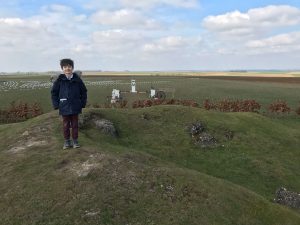 Today the site of the old windmill is an Australian memorial.
Today the site of the old windmill is an Australian memorial.
There is little to show for the previous structure except from some rubble of concrete where it had been reinforced into a stronghold by the Germans.
Back in 2016, for the 100th anniversary of the battle, a little memorial was established with crocheted poppy flowers memorialising the lost soldiers in the field below the windmill:
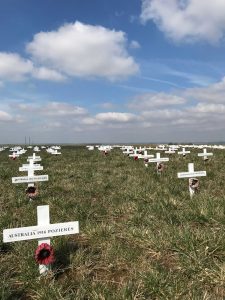
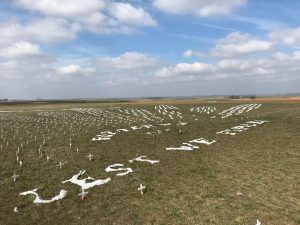
We visited the Memorial column and reflected on what it must have been like here 100 years ago…

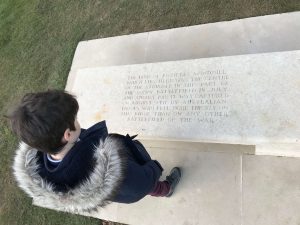
A lot to ponder under the incongruously beautiful sunny skies…
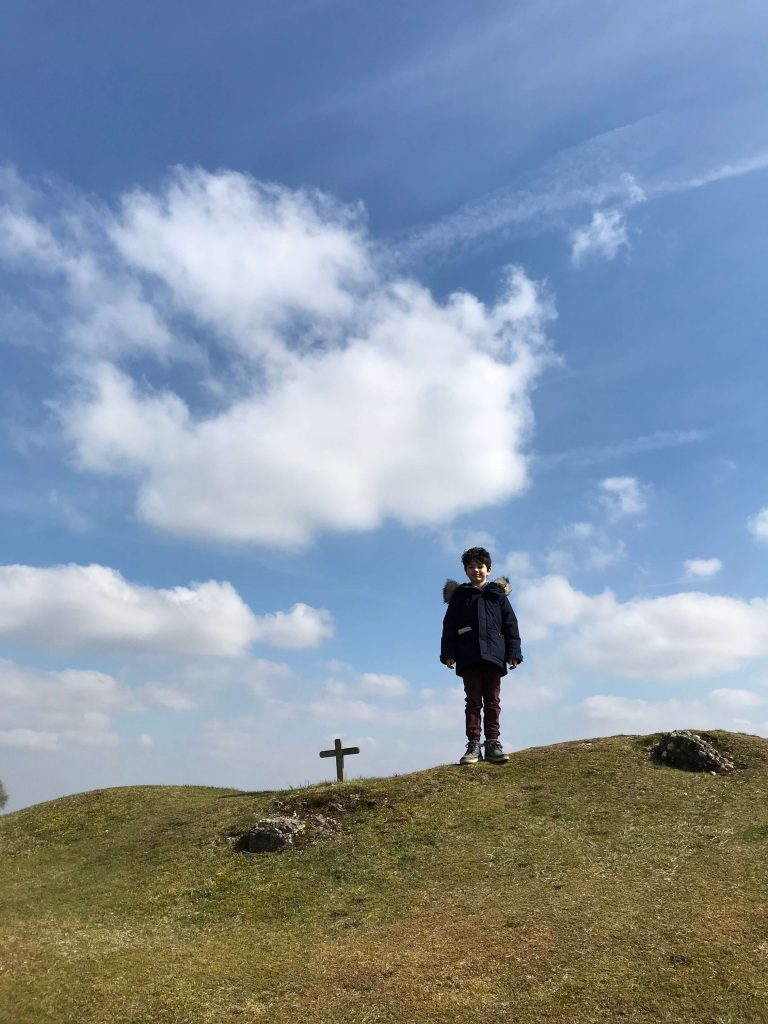
Remembrance
It had been a long day, but we still had a couple of stops to go.
The first was at a cemetery where Robert Inwood was buried. Sgt Inwood, also a South Australian, had fought with Arthur at both Gallipoli and Pozières, and to believe the accounts was instrumental more than once in Arthur’s survival. His older brother Roy, like Arthur was a VC recipient in WW1.
Sadly Sgt Inwood was killed in Pozières the day after the successful capture of the German trenches. He is one of the few fallen who has an identifiable tombstone however, so we visited his grave and left a poppy and a thought for him in the late afternoon sunshine.
A notable aspect of the cemetery is that it includes a tombstone dedicated to the unknown German soldiers fallen in the battle.
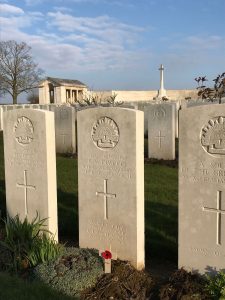
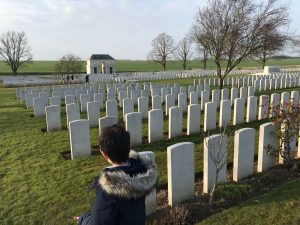
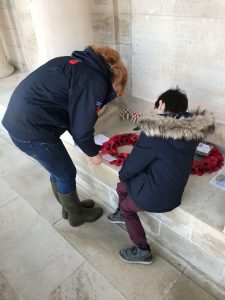 Last, Jackie had been asked by the relatives of a British soldier killed in action to leave a wreath that day to remember him.
Last, Jackie had been asked by the relatives of a British soldier killed in action to leave a wreath that day to remember him.
So we made one more stop, where Charles and Jackie quietly laid the wreath in a beautifully designed British cemetery that seemed a fitting setting for the end to a reflective and sobering day.
